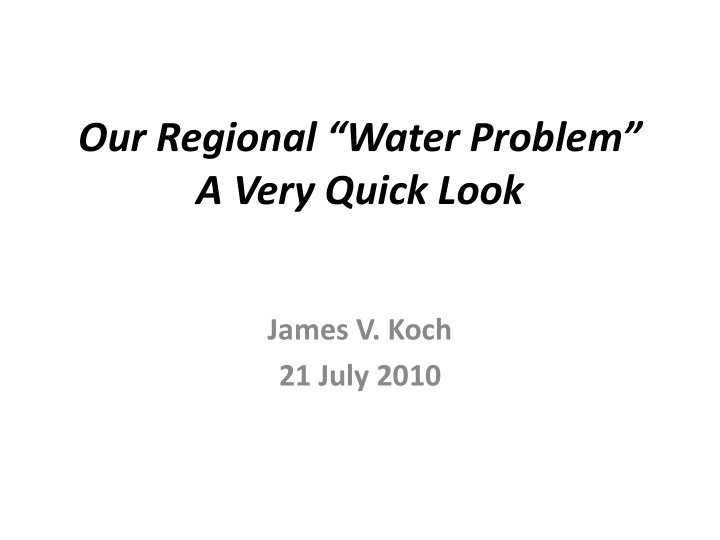



Our Regional “Water Problem” A Very Quick Look James V. Koch 21 July 2010
Trends, Regional Tidal Gauges, 1900-2008
Tidal Gauge, Gloucester Point, 1900-2008
Tidal Gauge, Sewell’s Point, 1900-2008
Rising Sea Levels, East Coast
DATE STORM TYPE ABOVE MHHW August 23, 1933 Hurricane 6.27 feet September 18, 2003 Hurricane Isabel 5.12 feet March 7, 1962 Ash Wednesday Storm 5.05 feet November 12, 2009 Veterans Day nor’easter 4.99 feet September 18, 1936 Hurricane 4.92 feet September 16, 1933 Hurricane 4.36 feet November 22, 2006 Thanksgiving nor’easter 3.96 feet October 6, 2006 Columbus Day nor'easter 3.76 feet January 28. 1998 Twin nor’easters (#1) 3.26 feet September 16, 1999 Hurricane Floyd 3.21 feet February 5, 1998 Twin nor’easters (#2) 3.12 feet www.wetlandswatch.org Source – NOAA Tides and Currents
www.wetlandswatch.org
www.wetlandswatch.org
Ft. Monroe Redevelopment www.wetlandswatch.org
East Ocean View Norfolk Redevelopment Terminals St. Patrick’s ODU N S Piers Light Rail Sentara www.wetlandswatch.org
www.wetlandswatch.org
Virginia Beach, VA Fort Story Atlantic Lynnhaven Shores Baylake Beach Ocean Broad Bay Lynnhaven Bay The Hampton Roads Conservation Corridor Study Legend Opportunities for Connectivity Suitability for Conservation High suitability - WATER QUALITY High suitability – HABITAT High suitability - BOTH
Impact of Sea Level Rise on Virginia Beach 2 foot sea level rise = loss of 200+ feet of beach 2100 Shoreline (max) www.wetlandswatch.org
Major Storms in H.R., 1970-2008
Hampton Roads # 10 in the World = total assets at risk from Sea Level Rise/Climate Extremes www.wetlandswatch.org
What Needs To Be Done 1) We need to recognize the nature of our challenge and place it high on our regional priority list. 2) We need more and better information. • We need precise regional ground mapping (LIDAR)- -- “Light Detection And Ranging” is an optical remote sensing technology that uses laser radar pulses to measure things. In this case, it is the ground and is done from an airplane. Some regional jurisdictions already have some of this information, or are in the process of acquiring it.
• We need improved GIS information. Literally, we need to know what’s what, and where it is, in our region. • We need better information on ground subsidence. Most of the ground east of Route 17 is slowly sinking and this is an important reason why our sea level problem is larger than it is in other East Coast metro areas.
3) We need to do “what ifs” (“if we do nothing” ) over the next several decades and the rest of the century---how much inundation will there be and where will it occur? • We need to compute prospective damages relating to the “what ifs” • We need to focus on plausible remedies • Poquoson provides a good example.
Poquoson Structural Count
Estimated Losses, Poquoson (AMEC)
Damaged Structures, Poquoson
• I would like HRPDC to consider going 50/50 with Old Dominion University on a project to do a Poquoson-like study for the entire region once we have LIDAR-quality mapping available. A primary aim will be to generate credible financial data that you can use at home as you talk to constituents and council members. This will not be the last word on the subject, but it will focus attention. However, we need to know precisely what is at stake. • Old Dominion University President John Broderick has designated water inundation as a priority University research area and ODU has brought together oceanographers, engineers and economists to tackle problems, consider solutions and seek funding.
4) More ahead on federal advisory and funding possibilities for any additional mapping needed, remedial actions (on- and off-shore defenses, building codes, storm surge gates, evacuations, etc). We can become a funded test regional site because: (a) our water problems may be more severe than those of most other regions; (b) our military presence; and, (c) most other large metro areas along the Atlantic Coast are not yet focused intently on the problem.
Recommend
More recommend